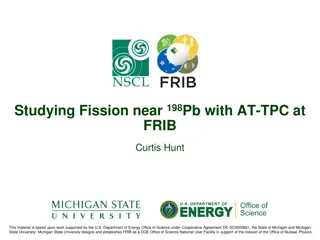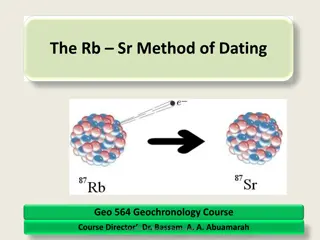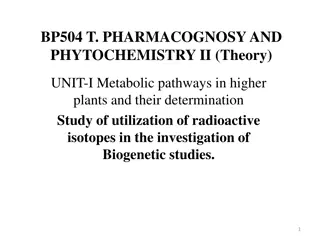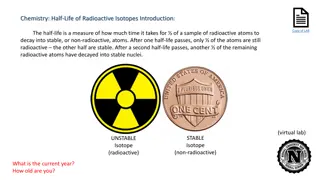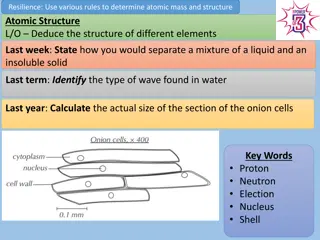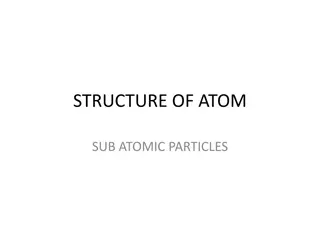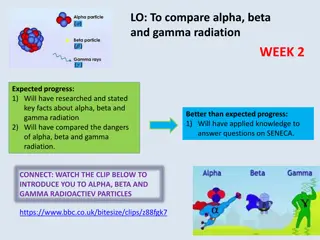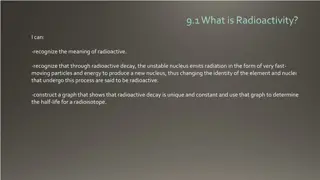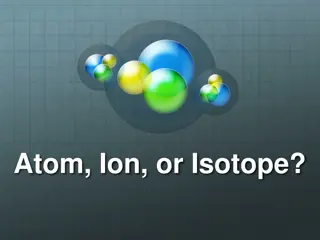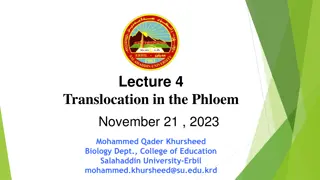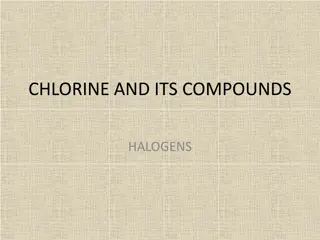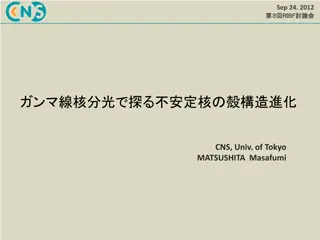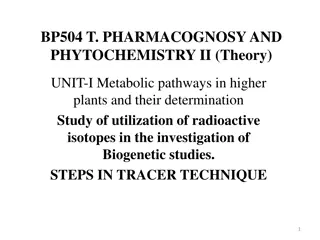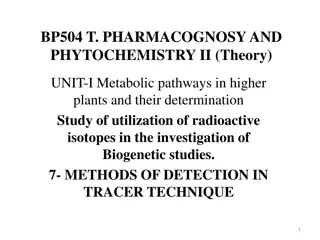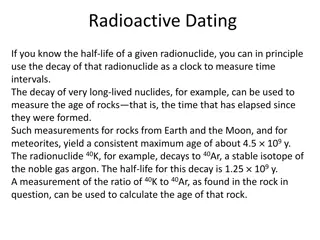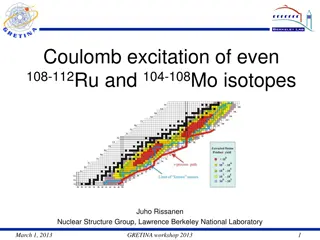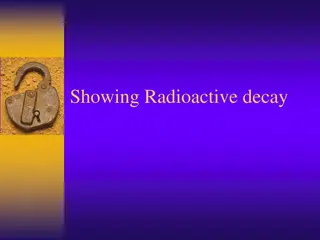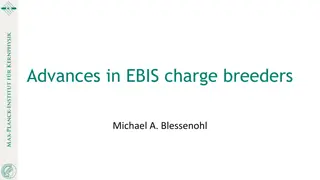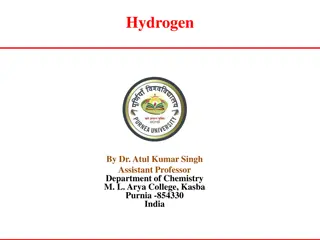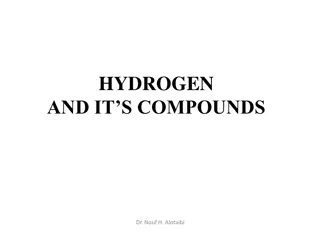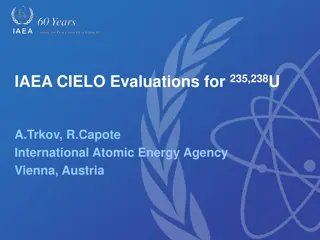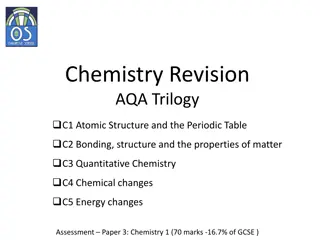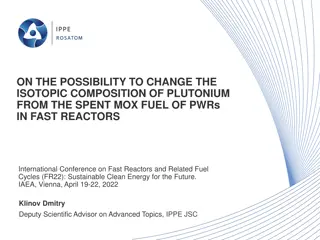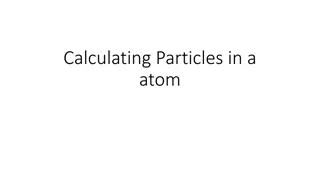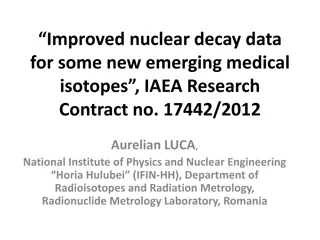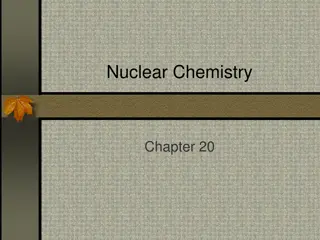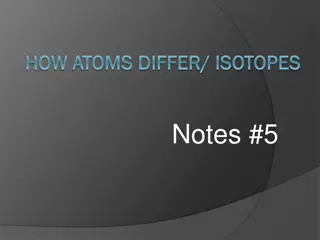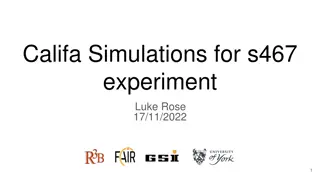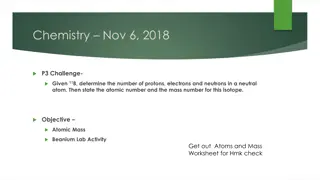Exploring Fission Near 198Pb with AT-TPC at FRIB: Insights from Curtis Hunt
Delve into the intriguing world of fission studies near 198Pb using the AT-TPC at FRIB. Supported by the DOE Office of Science, this research probes nuclear structure, fission properties, and fusion-fission reactions. By employing innovative techniques like the Heavy Isotope Tagger and active target
1 views • 39 slides
Advancing Nuclear Physics with Heavy Ion Storage Rings
Explore the world of rare isotopes and exotic ions through the use of Heavy Ion Storage Rings, enabling precision measurements, production of unstable nuclei, and beam-target interactions for studying nuclear processes and astrophysical relevance. Supported by the U.S. Department of Energy, this tec
5 views • 9 slides
Overview of Particle Accelerators and Isotope Production Methods
Explore various types of particle accelerators such as Direct Voltage Accelerators, Van de Graaff Generators, Tandem Van de Graaff Accelerators, and Linear Accelerators used in generating particles for isotope production, research, and industrial applications. These technologies play a crucial role
3 views • 22 slides
Understanding the Rb-Sr Method of Dating in Geochemistry
Explore the principles of the Rb-Sr dating method in geochemistry, focusing on radioactive decay of Rubidium and Strontium isotopes in geological materials. Learn about isotope data presentation, application in dating geological processes, and the significance of Rb and Sr in the periodic table.
3 views • 62 slides
Production of Radiopharmaceuticals
Radiopharmaceuticals play a crucial role in medical imaging, with a significant portion containing Tc-99m that requires chemical modification. Various Tc-labeled radiopharmaceuticals like DTPA, HIDA, MIBI, and others are used for imaging. Desirable properties of radionuclides include half-life suita
9 views • 32 slides
Exploration of Single Neutron Transfer on 68Ni at ISOLDE Workshop
Delve into the research on single-neutron transfer on 68Ni conducted by Andreas Ceulemans at the ISOLDE Workshop and Users Meeting in November 2023. The investigation focuses on the significance of studying nickel isotopes, the magicity and collectivity near 68Ni, and the use of shell model calculat
5 views • 26 slides
Techniques for Investigating Plant Metabolic Pathways and Biogenetic Studies
This content explores various techniques used in pharmacognosy and phytochemistry to investigate the metabolic pathways in plants and study the formation of primary and secondary metabolites. Methods such as utilizing radioactive isotopes, tracer techniques, isolated organs/tissues, grafting, and mu
4 views • 12 slides
Exploring Radioactive Decay: A Half-Life Lab Simulation
Explore the concept of radioactive decay through a virtual lab simulation involving strontium-90 (Sr-90) and yttrium-90 (Y-90) isotopes. Witness the decay process over multiple half-lives as unstable atoms transform into stable nuclei. Dive into the intricacies of half-life measurements and the vast
0 views • 10 slides
Understanding Electron Configurations and Atom Properties
Explore topics including electron configuration, full shells, atomic numbers, and properties of elements like Ytterbium, Bromine, Mercury, Magnesium, and Europium. Learn about isotopes, ions, and orbital electron distribution in atoms like Europium and Nitrogen, as well as practice completing electr
1 views • 10 slides
Understanding Atomic Structure and Subatomic Particles
Delve into the world of atomic structure and subatomic particles to reveal the inner workings of elements. Discover how to determine atomic mass, identify protons, neutrons, and electrons, and interpret the periodic table. Explore the key concepts of isotopes, electron configurations, and the charac
0 views • 6 slides
Exploring the Nature of Subatomic Particles and Light
Explore the intricate world of subatomic particles such as electrons, protons, and neutrons, and delve into the dual nature of light as both particles and waves. Discover the structure of atoms, their isotopes, atomic number, mass number, and the fundamental discoveries in the field of physics, incl
1 views • 16 slides
Understanding Alpha, Beta, and Gamma Radiation: a Comparative Analysis
Explore the key differences between alpha, beta, and gamma radiation, their structures, penetration powers, absorption materials, ionizing abilities, and dangers. Learn about isotopes, radioactive decay, and the unique characteristics of each type of radiation. Dive into creating fact sheets and und
2 views • 7 slides
Understanding Radioactivity and Nuclear Radiation
Radioactivity is the process in which unstable nuclei emit radiation, such as alpha, beta, or gamma particles, to become stable. This emission can change the element's identity and is crucial in fields like nuclear power and understanding Earth's core heat source. Different radioactive isotopes like
0 views • 12 slides
Understanding Atoms, Ions, and Isotopes in Chemistry
Atoms are neutral with equal protons and electrons. Ions are charged atoms resulting from gaining or losing electrons, while isotopes are atoms with varying numbers of neutrons. The atomic number always signifies the number of protons in an atom, unaffected by electron or neutron changes. Explore th
2 views • 5 slides
Understanding Translocation in the Phloem
This lecture explores the process of translocation in the phloem, supported by evidence from studies such as aphid experiments, ringing experiments, and the use of radioactive isotopes. It delves into the materials translocated in phloem sap, including water, sucrose, non-reducing sugars, nitrogen c
5 views • 18 slides
Chlorine and Halogens: Properties, Reactions, and Industrial Uses
Halogens, including chlorine, are in group 7 of the periodic table and have 7 electrons in their outer shell. They easily form negative ions by gaining an electron. Chlorine is symbolized as Cl and has two isotopes, 37Cl and 35Cl, with an electronic arrangement of 2:8:7. It can be prepared in the la
4 views • 31 slides
Advances in Nuclear Physics Research at RIKEN's RIBF Facility
Cutting-edge research at RIKEN's Radioactive Isotope Beam Factory (RIBF) in collaboration with the University of Tokyo, focusing on gamma-ray spectroscopy setups, in-beam experiments, and detector arrays like DALI2. The experiments involve studying reaction channels, Doppler shift effects, and explo
0 views • 20 slides
Exploring Radio Tracer Techniques in Pharmacognosy and Phytochemistry II
In this unit, the focus is on metabolic pathways in higher plants and leveraging radioactive isotopes for biogenetic studies. Topics covered include steps in tracer techniques, selection of radioisotopes, preparation of labeled compounds, and insertion of radio-labeled metabolites in plant parts usi
0 views • 9 slides
Methods of Detection in Tracer Technique for Biogenetic Studies
Explore the methods utilized in tracer techniques for investigating biogenetic pathways in plants. Learn about competitive feeding, precursor-product sequence method, sequential analysis, and isotope incorporation. These methods involve labeling experiments to trace metabolic pathways and understand
0 views • 17 slides
Introduction to Atomic Masses and Mass Spectrometry
Understanding atomic masses, isotopes, and mass spectrometry in the context of chemistry, particularly the concept of standard atomic mass unit (amu) and its application in measuring the masses of atoms. The content delves into the composition of atoms, isotopes, and how to determine the mass of an
1 views • 20 slides
Understanding Radioactive Dating Methods
The process of radioactive dating involves utilizing the decay of radionuclides to measure time intervals, with applications in determining the age of rocks and artifacts. Techniques such as radiocarbon dating, based on isotopes like 14C, enable scientists to determine the age of organic materials b
0 views • 4 slides
Coulomb Excitation Studies of Neutron-Rich Ru and Mo Isotopes
Workshop presentation on using GRETINA, CHICO, and CARIBU for Coulomb excitation studies of even Ru and Mo isotopes, exploring shape evolution through systematic studies and experimental limitations like beam intensity and purity. Analysis includes gamma intensities, level schemes, and nuclear reori
1 views • 11 slides
Understanding Radioactive Decay and Isotopes in Chemistry
Explore the fascinating world of radioactive decay, isotopes, and nuclear transformations in this educational resource. From reviewing atomic numbers to illustrating alpha and beta decay processes, discover the fundamental principles behind these phenomena with detailed explanations and visuals. Del
0 views • 17 slides
Understanding Atomic Mass and Isotopes in Atoms
Explore the concept of atomic mass in atoms, learn to compute atomic mass and mass number, identify isotopes, and calculate the number of neutrons in an atom. Understand the significance of the atomic number and mass number in determining the characteristics of elements.
0 views • 14 slides
Understanding Atomic Structure in Introductory Chemistry
Explore the basics of atomic structure in Introductory Chemistry, covering topics such as representing elements with atomic symbols, isotopes, and atomic bookkeeping. Learn through visual aids and examples to enhance your understanding of elements, isotopes, and atomic properties.
0 views • 21 slides
Advancements in Rare Isotope Research at EURISOL Town Meeting
Cutting-edge research and facility developments in the field of rare isotopes were showcased at the EURISOL Town Meeting in INFN - Pisa. Topics included advances in EBIS charge breeders, the ARIEL Extension facility, and the CANREB laboratory with Electron Beam Ion Source technology. Various aspects
0 views • 39 slides
Overview of Hydrogen: Properties, Isotopes, and Characteristics
Hydrogen, a colorless gas with atomic number 1 and mass 1.008 amu, exhibits electropositive and electronegative characteristics due to its electron configuration. It has three isotopes - protium, deuterium, and tritium - with varying reaction rates. Protium is the most abundant isotope. This element
0 views • 8 slides
Exploring Hydrogen and Its Compounds: Properties and Isotopes
Hydrogen, the most abundant element in the universe, has unique properties that make it resemble both alkali metals and halogens. It exists mainly in combined states, except in volcanic gases, and its isotopes exhibit distinct chemical and physical characteristics. The ionization energy of the H-H b
0 views • 37 slides
Understanding Isotopes in Biogeochemistry
Isotopes are atoms with the same number of protons but different numbers of neutrons. This presentation explores the significance of stable isotopes, types of isotopes, expressing isotopic abundances, isotope effects, and applications to geochemical studies. Learn about common light element stable i
0 views • 14 slides
IAEA CIELO Evaluations for Uranium Isotopes & Criticality Benchmarks Report
This report discusses the IAEA CIELO evaluations for uranium isotopes, focusing on the impact of Standards_2016 on criticality predictions, adjustments in nuclear model calculations using the Empire code, and incorporation of experimental data to enhance performance in integral benchmarks.
0 views • 7 slides
Chemistry Revision: Atomic Structure and the Periodic Table - AQA Trilogy
Explore key concepts in Chemistry Revision for AQA Trilogy including atomic structure, periodic table organization, separation techniques, symbol equations, electron structures, isotopes, and more. Learn about burning magnesium, crystallization, chromatography, fractional distillation, and propertie
0 views • 10 slides
Innovations in Reprocessing Spent MOX Fuel for Sustainable Nuclear Energy
Discussion at the FR22 Conference focuses on the potential for fast reactors to modify the isotopic composition of plutonium from spent MOX fuel of PWRs. By utilizing fast reactors like BN-800, countries can alter the fissile isotopes in plutonium, enabling its reuse in thermal reactors and effectiv
0 views • 8 slides
Understanding Copper Atoms: Protons, Electrons, Neutrons, Isotopes
Explore the intricacies of copper atoms, including calculations for protons, electrons, neutrons, mass number, and isotopes. Learn about the importance of oxidation states and electron configurations from the periodic table. Discover the isotope notation and final details for the element copper.
0 views • 8 slides
Enhanced Nuclear Decay Data for Medical Isotopes Research
Improved nuclear decay data for emerging medical isotopes was evaluated as part of an IAEA research contract. The process involved reviewing previous evaluations, gathering experimental data, compiling decay data sets, and disseminating results. Challenges at IFIN-HH/LMR included limited funding and
0 views • 32 slides
Understanding Nuclear Chemistry: A Comprehensive Overview
Explore the world of nuclear chemistry in Chapter 20, covering stable and unstable isotopes, radioactivity, radiation exposure, radioactive particles, types of radiation (alpha, beta, gamma), and how to stop radiation. Learn about isotopes, decay processes, and the impact of radiation on our daily l
0 views • 18 slides
Understanding Average Atomic Mass Calculation
Dive into the concept of calculating average atomic mass through fractional and percentage abundances of isotopes. Practice examples with carbon and mercury isotopes to grasp the methodology effectively.
0 views • 20 slides
Understanding Atoms and Isotopes in Chemistry
Understanding atoms and isotopes is essential in chemistry. Atoms consist of protons, neutrons, and electrons that determine their properties. Isotopes are atoms of the same element with different atomic masses due to varying numbers of neutrons. Learning how to determine subatomic particles and ato
0 views • 17 slides
Understanding Atomic Structure and Radioactivity
Explore the composition of atoms with protons, neutrons, and electrons, and learn about isotopes, nuclear notation, and the properties of subatomic particles. Understand radioactivity, including alpha, beta, and gamma radiation, and their impact on atomic and mass numbers. Discover the significance
0 views • 30 slides
Califa Simulations and Experimental Observations in Nuclear Physics Research
Exploring nuclear physics research through Califa simulations and experimental observations with a focus on PID gating, clustering algorithms, beam settings, and Ca isotopes chain gating. The study involves simulating events on CH2 targets, analyzing clustering effects, and observing opening angles
0 views • 10 slides
Beanium Lab Activity: Calculating Average Atomic Mass of Beanium Isotopes
Explore the Beanium Lab Activity where you analyze the percent abundance and average mass of White, Milk, and Dark chocolate bean isotopes to calculate the average atomic mass of Beanium. Understand the weighted average concept and how it relates to atomic mass calculations in chemistry.
0 views • 7 slides
